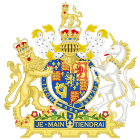Sir John Fenwick, 3rd Baronet
Sir John Fenwick, 3rd Baronet | |
|---|---|
 | |
| Born | c1645 |
| Died | 28 January 1697 |
| Nationality | Kingdom of England |
| Occupation(s) | MP and Jacobite conspirator |
| Known for | executed for treason |
| Spouse | Mary Fenwick born |
| Parent | Sir William Fenwick |
Sir John Fenwick, 3rd Baronet (c. 1645 – 28 January 1697) was an English Army officer and politician. He succeeded to the Fenwick baronetcy after the death of his father, Sir William Fenwick. A supporter of the Jacobite cause, Fenwick was involved in a conspiracy to assassinate William III of England, and was executed by beheading in 1697 as a result.
Life
Fenwick was the eldest son of
He had financial problems and in 1688 he sold the rump of the family estates and

Fenwick began to plot against the new King William, for which he underwent a short imprisonment in 1689 from May to October.
| Attainder of Sir John Fenwick Act 1696 | |
|---|---|
| Act of Parliament | |
 8 & 9 Will. 3. c. 4 | |
| Text of statute as originally enacted |
To save himself he offered to reveal all he knew about the

By his wife, Mary (d. 1708), daughter of Charles Howard, 1st Earl of Carlisle, and his wife Anne Howard, he had three sons and one daughter, all of whom died young, and are buried with Fenwick at St Martin-in-the-Fields.[2]
His wife had a memorial created for him in York Cathedral and she was buried there after she died on 27 October 1708.[2]
Notes
- ^ "BLACKETT, Sir William, 1st Bt. (1657-1705), of Greyfriars House, Newcastle-upon-Tyne and Wallington Hall, Northumb. | History of Parliament Online". www.historyofparliamentonline.org. Retrieved 6 May 2021.
- ^ a b c d . Dictionary of National Biography. London: Smith, Elder & Co. 1885–1900.
- ^ "William III, 1696-7: An Act to attaint Sir John Fenwick Baronett of High Treason. [Chapter IV. Rot. Parl. 8&9 Gul.III.p.1.nu.4.] | British History Online". www.british-history.ac.uk. Retrieved 6 May 2021.
- ^ "House of Lords Journal Volume 16: 15 January 1697 Pages 59-73 Journal of the House of Lords: Volume 16, 1696-1701. Originally published by His Majesty's Stationery Office, London, 1767-1830". British History Online. Retrieved 13 July 2020.
- ^ 1911 Encyclopædia Britannica - Fenwick, Sir John
References
- "Northumbrian Jacobites". Archived from the original on 15 April 2004.
- "Proceedings in Parliament against Sir John Fenwick, bart. upon a bill of attainder for High Treason". A Complete Collection of State Trials and Proceedings for High Treason and Other Crimes and Misdemeanors. 13 (394, column 537). 1812.
- Attribution
- This article incorporates text from a publication now in the public domain: Chisholm, Hugh, ed. (1911). "Fenwick, Sir John". Encyclopædia Britannica (11th ed.). Cambridge University Press.
- Old Bailey Proceedings Online (accessed 20 Jan 2022), Trial of John Fenwick. (o16960909-1, 9 September 1696).
